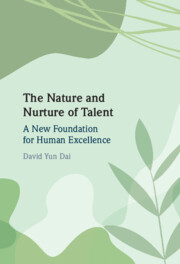Book contents
- The Nature and Nurture of Talent
- The Nature and Nurture of Talent
- Copyright page
- Dedication
- Contents
- Illustrations
- Foreword
- Acknowledgments
- Introduction Rationale, Goals, and Overview of the Book
- Chapter 1 The Evolving Complexity Theory of Talent Development
- Chapter 2 The Question of What Develops
- Chapter 3 The Question of How Talent Develops
- Chapter 4 The Question of When Critical Events Should Take Place
- Chapter 5 The Question of Where
- Chapter 6 How ECT Explains Various Talent Achievements
- Chapter 7 ECT in a Broader Landscape of Theoretic Models
- Chapter 8 Implications of ECT for Talent Identification and Assessment of Developmental Progressions
- Chapter 9 Implications of ECT for Promoting Human Excellence
- Chapter 10 Implications of ECT for Research Methodology
- Epilogue Is AI a Threat to Human Excellence?
- Postscript
- Glossary
- References
- Index
Chapter 6 - How ECT Explains Various Talent Achievements
Published online by Cambridge University Press: aN Invalid Date NaN
- The Nature and Nurture of Talent
- The Nature and Nurture of Talent
- Copyright page
- Dedication
- Contents
- Illustrations
- Foreword
- Acknowledgments
- Introduction Rationale, Goals, and Overview of the Book
- Chapter 1 The Evolving Complexity Theory of Talent Development
- Chapter 2 The Question of What Develops
- Chapter 3 The Question of How Talent Develops
- Chapter 4 The Question of When Critical Events Should Take Place
- Chapter 5 The Question of Where
- Chapter 6 How ECT Explains Various Talent Achievements
- Chapter 7 ECT in a Broader Landscape of Theoretic Models
- Chapter 8 Implications of ECT for Talent Identification and Assessment of Developmental Progressions
- Chapter 9 Implications of ECT for Promoting Human Excellence
- Chapter 10 Implications of ECT for Research Methodology
- Epilogue Is AI a Threat to Human Excellence?
- Postscript
- Glossary
- References
- Index
Summary
Chapter 6, based on bioecological effectivity, cultural complexity, and evolving individuality, develops a conceptual framework of levels of talent achievement that can explain a myriad of phenomena of talent achievement. Five levels are identified (modular talent, precocious masters, consummated masters, unrelenting innovators, and game-changers). Central to this framework is the distinction between masters and makers; the master’s job is to preserve and refine the inherited culture, and the maker’s job is to produce variation and deviation that changes culture. The two can create tensions between norms and freedom, between conservatism and progressivism. The chapter concludes the one long argument of ECT by summarizing the following five features: (1) the evolving complexity of social and developmental interactions and experiences that encompass biological, experiential, cognitive-affective, and sociocultural levels of analysis (Chapter 1); (2) the two “invisible hands” governing characteristic adaptation (direction) and maximal adaptation (persistence) (Chapters 2 and 3); (3) the three critical transitions for sustaining one’s long-term development (Chapter 4); (4) the four levels of self-organization toward excellence and evolving individuality; and (5) the five levels of talent achievement from masters and makers.
Keywords
- Type
- Chapter
- Information
- The Nature and Nurture of TalentA New Foundation for Human Excellence, pp. 130 - 153Publisher: Cambridge University PressPrint publication year: 2024



